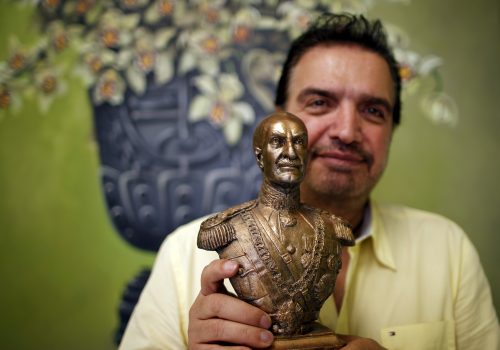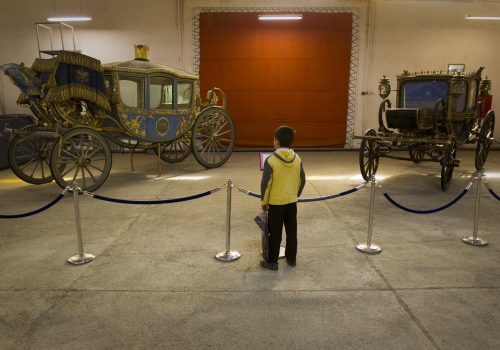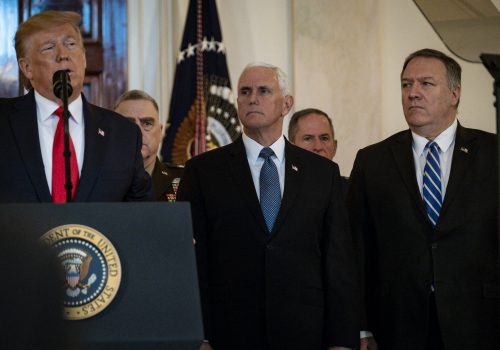Middle class Iranians sought to remake their nation. Here’s how they were betrayed.
The sclerotic ruling elite in Tehran had become corrupt and decadent, squandering the nation’s resources and becoming increasingly dependent on foreign superpowers like Russia. On the edges of the country, restless armed forces were agitating for change and, perhaps, even a dismemberment of Iran. Most importantly, the longtime rulers had lost the confidence of the country’s rising and increasingly anxious middle classes.
That was Iran exactly one hundred years ago, on the eve of the overthrow of the Qajar dynasty and the rise of Reza Khan, a Russian-trained army officer who seized power in a coup that coincided with the beginning of the fourteenth century on the Persian calendar. But that description of Iran would also be apt today, as it begins a new century in the year 1400.
There are broad continuities in the themes that have shaped Iran’s politics and society over the last century. The influence of Iran’s middle classes, who have at times aligned themselves with or steadfastly opposed those in power, has waxed and waned. Iran’s minorities—whether Kurds, Arabs, or Azeris along the far western borders or Baluchis at the far eastern frontier—have felt and continue to feel marginalized and oppressed. It has also been a time when admiration of the accomplishments of foreign powers repeatedly turned into hostility toward their interference and perceived cruelty.
But much has also changed in Iran over the last one hundred years. The country has grown from a largely agrarian country of ten million to an overwhelmingly urbanized nation of eighty-three million. Reza Khan was deposed by British and Russian forces and replaced by his son, Mohammed Reza Pahlavi in 1941. An occupation by allied forces brought misery and lingering trauma.
An upsurge in democratic aspirations prompted the nationalization of the oil industry and the rise and then overthrow of a popular leader—Prime Minister Mohammed Mossadegh—with Central Intelligence Agency and Secret Intelligence Service help in 1953. A petro-fueled expansion of the economy transformed the country, creating a vast new middle class, but also escalated the outsized ambitions of the monarchy, which came crashing down in a cataclysmic revolution. The Islamic regime that followed waged an epic eight-year war with Iraq (1980-1988) that transformed Iran and the Middle East.
Iran’s middle classes mushroomed, with a highly educated and literate population hungry for connections to the outside world. Even poorer Iranians, dislodged from rural districts and crammed into tiny urban apartments, adopted middle class aspirations for their children.
Through it all, Iran emerged as a modern state. Since the 1970s, Iran stopped being a vassal or client of any other world power, pursuing its own sometimes confounding regional policies; whether it was the Shah deploying troops and war planes to back the Omani Sultanate against leftists in the 1970s or Supreme Leader Ali Khamenei dispatching the Islamic Revolutionary Guard Corps to Syria to defend Bashar al-Assad in the 2010s.
“When you think in these very long terms there are some key continuities—but the changes matter more,” says Cyrus Schayegh, a scholar of Iranian and Middle East history at Geneva’s Graduate Institute for International Development Studies.
The alliance of Islamist clerics and military leaders that runs contemporary Iran has a keen sense of how the Qajars failed the country, just as it realizes full well how the failures of the Pahlavi dynasty shaped the way for the arrival of the Islamic Republic. But, in many ways, the current elite seem determined and possibly even tragically fated to repeat the mistakes of the past.
It has been said that the Western world’s twentieth century is bracketed by the 1912 sinking of the Titanic, which marked the end of the old nineteenth century order, and the terrorist attacks of September 11, 2001, which dashed the liberal illusions of the previous era.
Iran’s long fourteenth century arguably began with the hopes unleashed by the 1905-1911 Constitutional Revolution, through which the traditional middle classes sought to establish an empowered parliament and transform the relationship between citizen and state. That century came to a sad, symbolic end, with the January 2020 accidental shootdown of a Ukrainian Airways flight loaded with aspiring Iranian engineers, scientists, and scholars at the hands of regime officials who have yet to suffer any consequences for their actions.
Iranians of all classes dream of modernizing the country. But, at almost every turn during Iran’s last century, the regime in power has betrayed the middle classes that could serve as the pillar of a modern democratic state.
First, the Qajars and their allies in the clergy and among the Russians and British betrayed the constitutionalists and bombed the nascent parliament. Then, the Pahlavis and their American allies—especially financiers and weapons dealers—squelched the democratic yearnings of Iranians. Now, it’s the Islamic Republic and its backers in Beijing and Moscow that are throttling the middle class, with help from successive sanctions-addicted US administrations.
This short-circuiting of middle-class aspirations and consistent abuse of skilled professionals, merchants, artists, and thinkers, who drive modernity in other nations, may be what distinguishes Iran from the rest of the developing world.
“This is a very common political dimension that you see around the world—the rise of a middle class that challenges the aristocratic dominance of politics,” says Schayegh. “It’s an important element of the political game in the 20th century.”
Add to that a certain Iranian megalomania—the tendency for the nation’s leaders to overreach and fail to recognize their limits—and Iran’s fourteenth century trajectory becomes clearer. Even the calendar itself used and celebrated by Iranians has been changed several times throughout the past century, with Reza Pahlavi, his son, and the clerical regime each attempting to give it their own twist.
Reza Khan thought he could get away with playing Nazi Germany against the British and Russians and, in the later years of his rule, alienating the intelligentsia. He wound up being deposed by the British and the Americans so they could help Russia against Nazi Germany. Mossadegh’s mercurial personality and grandiose ambitions made it easier for his foreign and domestic enemies to oust him. Mohammad Reza Pahlavi may have delivered materially and even won over huge swaths of the country’s middle class, but his overbearing imperial pretensions and reckless fiscal policies ultimately turned both the new professionals and traditional merchants against him.
The Islamic Republic has in some ways expanded the middle class, but it has been unable to fully deliver economically because of the sanctions it has provoked and its own incompetence and corruption. The regime is ultimately an impediment to the nation’s social and political development.
More than anything, however, it is its overreach—its insistence on cramming an extremist ideological vision down the throats of Iranians—as well as Iraqis, Lebanese and others in the Middle East—that has made it so despised by domestic and foreign adversaries.
The regime now has been in power for forty-two years. It considers itself a break from the past. But, as far as Iran’s democratic aspirations go, it is not so different from its predecessors.
Borzou Daragahi is an international correspondent for The Independent. He has covered the Middle East and North Africa since 2002. He is also a nonresident fellow with the Atlantic Council’s Middle East Security Initiative. Follow him on Twitter: @borzou.
Image: Iranian family wear protective masks to prevent contracting a coronavirus, as they stand at Grand Bazaar in Tehran, Iran February 20, 2020. WANA (West Asia News Agency)/Nazanin Tabatabaee via REUTERS


